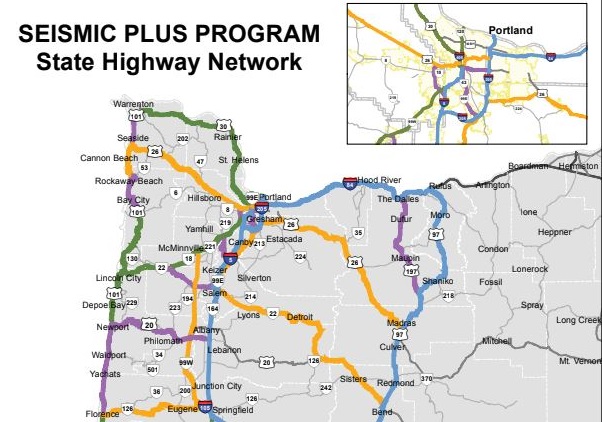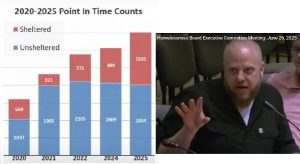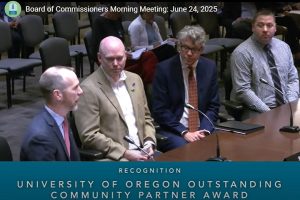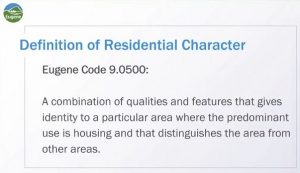Officials request at least one bridge to the hospital that will survive the earthquake
8 min read
Local officials sharply criticized the Oregon Department of Transportation for prioritizing Highway 99 bridges for seismic upgrades. Eugene City Councilor Randy Groves said under the current plan, in the event of an earthquake, most Lane County residents would be cut off from a hospital. At the Metropolitan Policy Committee June 6:
[00:00:24] Bert Hartman (ODOT Bridge Program, managing engineer): In 2014, ODOT did what’s called a Seismic Plus Report, and that was: How can we address the seismic needs in Oregon? And it was a planning level study, and it was broken into five different phases, essentially $1 billion each, with 2014 dollars.
[00:00:42] So now it’s 2024. We can look back and say, you know, we didn’t get that $1 billion of seismic funding for 2014… So now we have, what are we going to do from Eugene to Portland?
[00:00:58] We had planned to continue on, on I-5. But what that does, it gives us basically two bad choices. The bridges are 60 to 70 years old, and they’ve probably got another 30 years of service life in them, and they’re perfectly fine, except for seismic.
[00:01:16] So we’ve got two choices. Well, the first bad choice is to replace a bridge with decades of service life left in it. And the second bad choice is to put millions of dollars into a 60- or 70-year-old bridge and then replace it in 30 years.
[00:01:35] Before we even got a seismically resilient route from Eugene to Portland, we’d be replacing some of the very bridges that we did a seismic retrofit on. So that is not a good approach.
[00:01:46] So we thought, what can we do from Eugene to Portland? And we looked at different options. We could have used different state highways, a combination of local roads. What we determined is, is we can just use basically (Highway) 99. And that’s (Highway) 99 W. If we do that, we have a lot less vulnerable bridges than I-5 has. We have local detours are available. So, even as we’re improving this route, we can still make use of it, if we have the earthquake prior to having the route complete.
[00:02:22] Randy Groves (Eugene, city councilor): Thank you, Bert, for the presentation and the update on this. That’s very helpful. I’m very concerned in the fact that most of Lane County cannot get to any hospital in our region using surface streets. We have I-5 that we have to cross. In many cases, we have the Willamette River. There’s multiple, multiple spans.
[00:02:44] And what I’m interested in is knowing what kind of priority we can get on seismically upgrading, you know, at least a route or two in, so we’ve got a way to fall back on in the case of an emergency.
[00:02:58] You know: ‘If it’s predictable, it’s preventable.’ And this is something that I think is a catastrophe that’s predictable.
[00:03:06] Bert Hartman (ODOT): Well, to get a seismically resilient route, you need to replace the bridges with new bridges. So right now for the state program, I’m focused on condition. When I replace a bridge, I’m getting a seismically resilient bridge. I’m focusing on replacing bridges that need it based on condition.
[00:03:27] Unless there’s a big chunk of money that’s devoted to seismic, you’re not going to get new bridges on seismic grounds.
[00:03:37] Randy Groves (Eugene): Well, with all due respect, I think just having a singular scale of how you’re rating these and how you are prioritizing upgrades is, it’s not responsible. I think you need to also be thinking, how are we going to move people in all kinds of conditions, but especially in a large seismic event.
[00:03:57] And the reality is, it’s not ‘if’ this is going to happen. We know it’s going to happen. It may not be in our lifetimes, but it is going to happen. And I really believe strongly that routes need to be taken into consideration in the decision matrix, not just how a bridge is rated.
[00:04:16] Bert Hartman (ODOT): Well, we are taking into account routes because we’re using the seismic routes where we prioritize the most important routes in the state, which is the Phase 1 routes. We address (Highway) 97, we address (Highway) 58. And we’re going to address Eugene north using (Highway) 99 W. So we are route-specific.
[00:04:38] Randy Groves (Eugene): That sounds a little different than what you said a minute ago. You said it was based solely on the stability and rating of the bridge.
[00:04:47] Bert Hartman (ODOT): Well, we’re replacing bridges on Highway 99. We’re prioritizing that route.
[00:04:54] Randy Groves (Eugene): That doesn’t get anybody to a hospital.
[00:04:56] Bert Hartman (ODOT): Well, it takes money to replace bridges.
[00:04:59] Randy Groves (Eugene): Okay. I feel like we’re having a circular discussion. It still seems that needs to be a level of prioritization for how we get a very large portion of our population, and I’m talking about Lane County, I’m not just talking about the city of Eugene: How do we get people to a hospital? And if we don’t have a seismically secure route, we’re not going to be able to get there.
[00:05:25] Bert Hartman (ODOT): There are seismic engineers working with all the counties on our seismic lifeline routes. And once we get those, we can get some priorities and get some funding.
[00:05:35] Randy Groves (Eugene): Who do we need to talk to, to get this thing elevated?
[00:05:38] Bert Hartman (ODOT): I would talk to the director’s office.
[00:05:42] Randy Groves (Eugene): Thank you.
[00:05:45] Pat Farr (Lane County commissioner): I just want to tag along with Chief Groves. And I want to underline that this is Chief Groves and I don’t know, Mr. Hartman, if you know that Chief Groves was the Eugene Springfield Fire chief and his knowledge of routes to hospitals should be listened to by the highest authorities. And I would hope and expect that you would be an asset to us in talking to the director in making certain that routes to the hospitals are prioritized in bridge reconstruction.
[00:06:08] Bridges do cost money. Lives are irreplaceable. And our routes to hospitals are absolutely essential, and if you’ve not used that in your matrix, for the nature of the essential routes that you’re planning the bridge replacement on, your matrix needs to be revised. I’m not suggesting that you haven’t used it in the matrix, but we need to be assured that it has been, and I stand behind Chief Groves on this, that at the very highest level this needs to be reconsidered.
[00:06:35] Susan Cox (Lane Transit District, board member): One of the things that I wanted to just remind everyone is the bridge that goes across Franklin also is the main hub to LTD and that transportation system, so, from that perspective, it needs to be on the priority list. I appreciate all this information. It’s very sobering.
[00:06:58] Lucy Vinis (Eugene, mayor): I really just wanted to support what Councilor Groves was saying and Commissioner Farr. We need to prioritize these routes for survival in a Cascadia event and so I just wanted to chime in.
[00:07:13] David Loveall (Lane County commissioner): Good deal. Thank you for that comment. Yeah, I couldn’t agree more with Councilor Groves’s comments as well. I mean, he’s the guy who is the expert. I’m just kind of curious if this particular information, Bert, would come back to us at a later date, soon, that we could know if the prioritizes were realigned to help us out with that. Is that something that you’re interested in?
[00:07:33] Bert Hartman (ODOT): I’ll work with our seismic standards engineer and see what status that Lane County is for the lifeline routes.
[00:07:42] David Loveall (Lane County): And I’m wondering how we can help that along. Is there something that I can do as chair to help that along, meet with people with you or how can I help?
[00:07:49] Bert Hartman (ODOT): I will take your name and I’ll pass it on.
[00:07:53] David Loveall (Lane County): Okay. All right. I appreciate that, sir, very much.
[00:07:56] Vidal Francis (ODOT): And I think that the concern here is valid. You know, the truth is, the most important thing is: How can we keep people alive? How can we keep our community moving such that we can stay alive, to be honest with you.
[00:08:12] And I’m happy to sit with you, Mr. Groves, if you will, or this whole body, to be honest with you, to sit down and actually look at those routes because again, there may be, ‘disconnect’ is not the right word, there may be something that may not be seen in terms of what we’re looking at as far as priority routes versus what Lane County is looking at as far as priority routes. And if we can come to a place where we both can kind of agree or see the same things that you’re seeing, I think that would be helpful for all. And I’m happy to discuss that with you offline.
[00:08:42] Or at some point, I actually, I’d love, to be honest with you, because again, on my end of things, I’m looking at what’s happening around Lane County, if you will. And there is a few bridges I know, and I think Bert, who, who helps me a lot with some of the bridge work that needs to be done around here, he hears from me some of the needs that I have as far as what needs to be replaced, what needs to go where.
[00:09:06] So again, if we can have that conversation, if even if it’s just me, you and Commissioner Farr, I’m happy to sit down. (I’ll be a part of that). Let’s have that conversation to see what your priority is as far as what’s significant, what needs to be addressed. And obviously, where our state system overlaps on top of that.
[00:09:26] David Loveall (Lane County): Great suggestion. Yeah, I’m hoping that Mr. Hartman, you get together on that for sure. Looks like we’ve got some more work to do on this item going forward. Like I said, Mr. Hartman, thank you for your time. I appreciate it and we’re willing to work with you. You’ve got a few eager people that are willing to hitch onto that wagon to make that a priority, sir. So I’m hopeful that we can do that and work together.
[00:09:46] Bert Hartman (ODOT): Yeah, excellent. Thanks.
[00:09:47] John Q: The closure of Eugene’s University District hospital is having a ripple effect throughout the city and county as residents and agencies adapt to the change. Now ODOT may be forced to adapt its plans for seismic lifeline routes.





